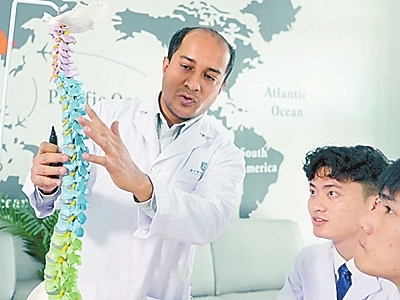
Liu Minxia mllmx@msn.com IF Yan Ning, the top scientist who recently joined the founding team of Shenzhen Medical Academy of Research and Translation as a full-time member, is among the brightest stars that have burnished the image of Shenzhen’s medical sector, young and promising medical experts like Dr. Atik Badshah Shaikh are rising stars that are adding to its luster. Shaikh, 32, has been studying and working in China for the past 17 years. Five years ago, after completing his Ph.D. studies in Hong Kong, he moved to Shenzhen for his post-doctoral research. He joined Southern University of Science and Technology (SUSTech) Hospital in 2020 as a member of its international medical administration, responsible for the advancement of the hospital’s internationalization drive. “I choose to work here because I think Shenzhen is a young city. It’s developing and progressing rapidly. I can get a lot of opportunities here, especially as there are many new hospitals coming up in Shenzhen and they’ve all adopted internationalization as their motto,” Shaikh said. The young medical expert, originally from India, has settled with a family in Shenzhen, living in Bao’an District with his Chinese wife and two children. Over the years living and working in the city, Shaikh has gained insights into Shenzhen’s medical services sector both as a user and service provider. Shaikh found that Shenzhen’s medical sector has transformed itself in an all-round manner over the past few years by adopting innovative approaches, including bringing in medical expertise from within and outside of the country, and taking advantage of the city’s strengths in high technology. While marveling at the great strides Shenzhen has taken to improve its health care services, he also offered his suggestions and visions for its future development. According to Shaikh, for a first-time hospital-goer, their first impression on the city’s health care system would be the convenience. “All the services, [including] medical services as well as the administration services, have gone online, which provides easy access to medical consultation,” he said. “People can make an appointment, make payments, as well as see the results online through their phones. With just a click of a button, they can get all the services.” On closer examination, one can find Shenzhen’s medical care has the capability to meet patients’ high demands, with high-quality medical expertise from home and abroad accessible in the city, he said. Shaikh gave credit to the city government’s innovative endeavors in this regard, citing the so-called “Three-Famous Health Project,” an initiative the Shenzhen government started in 2014 to encourage renowned medical experts, hospitals and clinics from home and abroad to establish a presence in the city. Shaikh thinks initiatives like this are beneficial to hospitals, patients and medical students as well, creating “a win-win situation for all.” Shaikh, who is an orthopedic expert and plans to join the hospital’s orthopedic center as a doctor in March, said he suggests that authorities take measures to lure more young medical experts like him to work here and contribute to the development of the city’s health care sector. To that end, Shaikh also suggested that authorities need to pay attention to some details that can make the city more international and accommodating to expats, for example, rendering bilingual online public service platforms like in Singapore and China’s Hong Kong. Shenzhen’s innovative culture sweeps way beyond the medical care sector and, considering the innovations the city has made in various sectors, Shaikh dubbed Shenzhen as the world’s innovation hub. “Over the past few years, with innovations in electric vehicles, autonomous driving vehicles, robotics and the development of AI, I feel it has become the world’s innovation hub,” he said. | 
